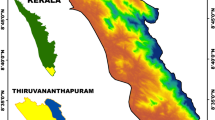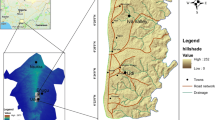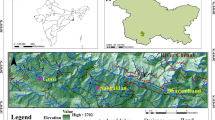Abstract
Landslides are one the most destructive and life-endangering hazard in the Darjeeling Himalayan region and keeping in mind the interest of society and their future prospects identification of landslide potential areas is a very pertinent task in this area. Therefore, the present study aimed toward the landslide susceptibility zonation (LSZ) mapping in and around the Kalimpong region by applying Analytic Hierarchy Process (AHP) method integrated with fifteen causative factors including slope, lineament, drainage density, land use land cover, relative relief, soil texture, lithology, elevation, aspect, thrust and faults, plan curvature, profile curvature, road network, topographic wetness index and stream power index. Tolerance and variance inflation factors with Pearson's correlation coefficient are used to assess potential collinearity among the selected factors, and subsequently, the final model has been constructed by enduring an acceptable consistency ratio (<0.10). Thereafter, to classify this region into very low, low, moderate, high and very high susceptible zones quantile, geometric interval, Jenk’s natural break and success rate curve (SRC) techniques are adopted to compare and check the optimum LSZ categorization. Considering the identified 647 landslides, Area Under Curve (AUC) of Receiver Operating Characteristic (ROC) curve is used to gauge the best LSZ map. The AUC ROC shows SRC method (m = 0.9) yields the highest result, achieving a prediction accuracy of 79.5% and, therefore, is considered the most promising LSZ form for the present study area. The results obtained from the study highlight the spatial information of areas that may face slope instability and helps government agencies, stakeholders for drafting adequate measures due to absence of proper landslide early warning systems in this region.









Similar content being viewed by others
Explore related subjects
Discover the latest articles and news from researchers in related subjects, suggested using machine learning.Availability of data and material
The datasets generated during and/or analyzed in this study are available from the corresponding author on reasonable request.
Code availability
Not applicable.
Change history
17 August 2022
A Correction to this paper has been published: https://doi.org/10.1007/s10661-022-10053-4
References
Acharyya, S. K. (1980). Structural framework and tectonic evolution of the eastern Himalaya. Himalayan Geology, 10, 412–439.
Aleotti, P., & Chowdhury, R. (1999). Landslide hazard assessment: Summary review and new perspectives. Bulletin of Engineering Geology and the Environment, 58(1), 21–44. https://doi.org/10.1007/s100640050066
Arabameri, A., Saha, S., Roy, J., Chen, W., Blaschke, T., & Tien Bui, D. (2020). Landslide susceptibility evaluation and management using different machine learning methods in the Gallicash River Watershed Iran. Remote Sensing, 12(3), 475. https://doi.org/10.3390/rs12030475
Basu, T., & Pal, S. (2018). Identification of landslide susceptibility zones in Gish River basin West Bengal India. Georisk: Assessment and Management of Risk for Engineered Systems and Geohazards, 12(1), 14–28. https://doi.org/10.1080/17499518.2017.1343482
Bhandari, R. K. (2006). The Indian landslide scenario strategic issues and action points. In India disaster management congress, New Delhi (pp. 29–30).
Bui, D. T., Tuan, T. A., Klempe, H., Pradhan, B., & Revhaug, I. (2016). Spatial prediction models for shallow landslide hazards: A comparative assessment of the efficacy of support vector machines artificial neural networks kernel logistic regression and logistic model tree. Landslides, 13(2), 361–378. https://doi.org/10.1007/s10346-015-0557-6
Chakraborty, I., Ghosh, S., Bhattacharya, D., & Bora, A. (2011). Earthquake induced landslides in the Sikkim-Darjeeling Himalayas–An aftermath of the 18th September 2011 Sikkim earthquake. Kolkata: Geological Survey of India.
Chen, S., Miao, Z., Wu, L., & He, Y. (2020). Application of an Incomplete Landslide Inventory and One Class Classifier to Earthquake-Induced Landslide Susceptibility Mapping. IEEE Journal of Selected Topics in Applied Earth Observations and Remote Sensing, 13, 1649–1660.
Chung, C. J. F., & Fabbri, A. G. (2003). Validation of spatial prediction models for landslide hazard mapping. Natural Hazards, 30(3), 451–472. https://doi.org/10.1023/B:NHAZ.0000007172.62651.2b
Cruden, D. M., & Varnes, D. J. (1996). Landslide types and processes. In A. K. Turner & R. L. Schuster (Eds.), Landslides: Investigation and mitigation Special Report 247 (pp. 36–75). National Research Council, Transportation and Research Board.
Djukem, W. D. L., Braun, A., Wouatong, A. S. L., Guedjeo, C., Dohmen, K., Wotchoko, P., et al. (2020). Effect of soil geomechanical properties and geo-environmental factors on landslide predisposition at Mount Oku Cameroon. International Journal of Environmental Research and Public Health, 17(18), 6795.
EM-DAT International Disaster Database. (2020). Université Catholique de Louvain, Brussels, Belgium. Accessed on September 6, 2020, from http://www.em-dat.net/
Froude, M. J., & Petley, D. N. (2018). Global fatal landslide occurrence from 2004 to 2016. Natural Hazards and Earth System Sciences, 18(8), 2161–2181. https://doi.org/10.5194/nhess-18-2161-2018
Gangopadhyay, P. K. (1995). Intrafolial folds and associated structures in a progressive strain environment of Darjeeling-Sikkim Himalaya. Proceedings of the Indian Academy of Sciences-Earth and Planetary Sciences, 104(3), 523.
Ghosh, S., Carranza, E. J. M., van Westen, C. J., Jetten, V. G., & Bhattacharya, D. N. (2011). Selecting and weighting spatial predictors for empirical modeling of landslide susceptibility in the Darjeeling Himalayas (India). Geomorphology, 131(1–2), 35–56. https://doi.org/10.1016/j.geomorph.2011.04.019
Goetz, J. N., Brenning, A., Petschko, H., & Leopold, P. (2015). Evaluating machine learning and statistical prediction techniques for landslide susceptibility modeling. Computers & Geosciences, 81, 1–11. https://doi.org/10.1016/j.cageo.2015.04.007
Govt. of West Bengal. (2017). Annual Flood Report (Jalasampad Bhavan, Salt Lake Kolkata – 7000 091).
Guri, P. K., & Patel, R. C. (2015). Spatial prediction of landslide susceptibility in parts of Garhwal Himalaya India using the weight of evidence modelling. Environmental Monitoring and Assessment, 187(6), 1–25. https://doi.org/10.1007/s10661-015-4535-1
Guzzetti, F. (2002). Landslide hazard assessment and risk evaluation: Limits and prospectives. In Proceedings of the 4th EGS Plinius Conference, Mallorca, Spain (pp. 2–4).
Guzzetti, F., Reichenbach, P., Ardizzone, F., Cardinali, M., & Galli, M. (2006). Estimating the quality of landslide susceptibility models. Geomorphology, 81(1–2), 166–184. https://doi.org/10.1016/j.geomorph.2006.04.007
IndiaWRIS (India Water Resource Information System). Ministry of Jal Shakti Govt. of India. Accessed on April 10, 2021, from https://indiawris.gov.in
Kalantar, B., Ueda, N., Saeidi, V., Ahmadi, K., Halin, A. A., & Shabani, F. (2020). Landslide susceptibility mapping: Machine and ensemble learning based on remote sensing big data. Remote Sensing, 12(11), 1737.
Kanungo, D. P., Arora, M. K., Sarkar, S., & Gupta, R. P. (2006). A comparative study of conventional ANN black box fuzzy and combined neural and fuzzy weighting procedures for landslide susceptibility zonation in Darjeeling Himalayas. Engineering Geology, 85(3–4), 347–366. https://doi.org/10.1016/j.enggeo.2006.03.004
Karmokar, S., & De, M. (2020). Flash flood risk assessment for drainage basins in the Himalayan foreland of Jalpaiguri and Darjeeling Districts West Bengal. Modeling Earth Systems and Environment, 6, 2263–2289. https://doi.org/10.1007/s40808-020-00807-9
Kellett, D., Grujic, D., Mot-tram, C., Mukul, M., & Larson, K.P. (2014). Virtual field guide for the Darjeeling-Sik-kim Himalaya India. In C. Montomoli, R. Carosi, R. Law, S. Singh, & S. M. Rai (Eds.), Geological field trips in the Himalaya Kar-akoram and Tibet. Journal of the Virtual Explorer, Electronic Edition, ISSN, 1441–8142.
Khanna, K., Martha, T. R., Roy, P., & Kumar, K. V. (2021). Effect of time and space partitioning strategies of samples on regional landslide susceptibility modelling. Landslides, 18(6), 2281–2294. https://doi.org/10.1007/s10346-021-01627-3
Kumar, R., & Anbalagan, R. (2016). Landslide susceptibility mapping using analytical hierarchy process (AHP) in Tehri reservoir rim region Uttarakhand. Journal of the Geological Society of India, 87(3), 271–286. https://doi.org/10.1007/s12594-016-0395-8
Mandal, B., & Mandal, S. (2018). Analytical hierarchy process (AHP) based landslide susceptibility mapping of Lish river basin of eastern Darjeeling Himalaya India. Advances in Space Research, 62(11), 3114–3132. https://doi.org/10.1016/j.asr.2018.08.008
Mandal, P., & Sarkar, S. (2021). Estimation of rainfall threshold for the early warning of shallow landslides along National Highway-10 in Darjeeling Himalayas. Natural Hazards, 105(3), 2455–2480. https://doi.org/10.1007/s11069-020-04407-9
Martha, T. R., van Westen, C. J., Kerle, N., Jetten, V., & Kumar, K. V. (2013). Landslide hazard and risk assessment using semi-automatically created landslide inventories. Geomorphology, 184, 139–150. https://doi.org/10.1016/j.geomorph.2012.12.001
Meena, S. R., Mishra, B. K., & Tavakkoli Piralilou, S. (2019). A hybrid spatial multi-criteria evaluation method for mapping landslide susceptible areas in kullu valley Himalayas. Geosciences, 9(4), 156. https://doi.org/10.3390/geosciences9040156
Milevski, I., Dragićević, S., & Zorn, M. (2019). Statistical and expert-based landslide susceptibility modeling on a national scale applied to North Macedonia. Open Geosciences, 11(1), 750–764.
Mukul, M., Srivastava, V., & Mukul, M. (2017). Out-of-sequence reactivation of the Munsiari thrust in the Relli River basin Darjiling Himalaya India: Insights from Shuttle Radar Topography Mission digital elevation model-based geomorphic indices. Geomorphology, 284, 229–237. https://doi.org/10.1016/j.geomorph.2016.10.029
NDMA. (2019). Compendium of task force sub group reports on National Landslide Risk Management Strategy.
Oguchi, T., Aoki, T., & Matsuta, N. (2003). Identification of an active fault in the Japanese Alps from DEM-based hill shading. Computers & Geosciences, 29(7), 885–891. https://doi.org/10.1016/S0098-3004(03)00083-9
Ohlmacher, G. C. (2007). Plan curvature and landslide probability in regions dominated by earth flows and earth slides. Engineering Geology, 91(2–4), 117–134.
Ozioko, O. H., & Igwe, O. (2020). GIS-based landslide susceptibility mapping using heuristic and bivariate statistical methods for Iva Valley and environs Southeast Nigeria. Environmental Monitoring and Assessment, 192(2), 1–19. https://doi.org/10.1007/s10661-019-7951-9
Park, H. J., Lee, J. H., & Woo, I. K. (2013). Assessment of rainfall-induced shallow landslide susceptibility using a GIS-based probabilistic approach. Engineering Geology, 161, 1–15. https://doi.org/10.1016/j.enggeo.2013.04.011
Patil, A. S., Bhadra, B. K., Panhalkar, S. S., & Patil, P. T. (2020). Landslide Susceptibility Mapping Using Landslide Numerical Risk Factor Model and Landslide Inventory Prepared Through OBIA in Chenab Valley Jammu and Kashmir (India). Journal of the Indian Society of Remote Sensing, 48(3), 431–449. https://doi.org/10.1007/s12524-019-01092-5
Patra, A., & Saha, D. (2019). Stress regime changes in the Main Boundary Thrust zone Eastern Himalaya decoded from fault-slip analysis. Journal of Structural Geology, 120, 29–47. https://doi.org/10.1016/j.jsg.2018.12.010
Pham, B. T., Pradhan, B., Bui, D. T., Prakash, I., & Dholakia, M. B. (2016). A comparative study of different machine learning methods for landslide susceptibility assessment: A case study of Uttarakhand area (India). Environmental Modelling & Software, 84, 240–250. https://doi.org/10.1016/j.envsoft.2016.07.005
Phong, T. V., Phan, T. T., Prakash, I., Singh, S. K., Shirzadi, A., Chapi, K., et al. (2019). Landslide susceptibility modeling using different artificial intelligence methods: A case study at Muong Lay district Vietnam. Geocarto International, 36(15), 1685–1708. https://doi.org/10.1080/10106049.2019.1665715
Pourghasemi, H. R., Pradhan, B., & Gokceoglu, C. (2012). Application of fuzzy logic and analytical hierarchy process (AHP) to landslide susceptibility mapping at Haraz watershed Iran. Natural Hazards, 63(2), 965–996.
Pradhan, A. M. S., & Kim, Y. T. (2016). Evaluation of a combined spatial multi-criteria evaluation model and deterministic model for landslide susceptibility mapping. CATENA, 140, 125–139. https://doi.org/10.1016/j.catena.2016.01.022
Roy, J., & Saha, S. (2019). Landslide susceptibility mapping using knowledge driven statistical models in Darjeeling District West Bengal India. Geoenvironmental Disasters, 6(1), 1–18. https://doi.org/10.1186/s40677-019-0126-8
Saaty, T. L., & Wind, Y. (1980). Marketing applications of the analytic hierarchy process. Management Science, 26(7), 641–658. https://doi.org/10.1287/mnsc.26.7.641
Saha, A. K., Gupta, R. P., Sarkar, I., Arora, M. K., & Csaplovics, E. (2005). An approach for GIS-based statistical landslide susceptibility zonation–with a case study in the Himalayas. Landslides, 2(1), 61–69. https://doi.org/10.1007/s10346-004-0039-8
Sarkar, S., & Kanungo, D. P. (2004). An integrated approach for landslide susceptibility mapping using remote sensing and GIS. Photogrammetric Engineering & Remote Sensing, 70(5), 617–625.
Sarkar, S., Kanungo, D. P., & Sharma, S. (2015). Landslide hazard assessment in the upper Alaknanda valley of Indian Himalayas. Geomatics Natural Hazards and Risk, 6(4), 308–325. https://doi.org/10.1080/19475705.2013.847501
Sarkar, S., Roy, A. K., & Martha, T. R. (2013). Landslide susceptibility assessment using information value method in parts of the Darjeeling Himalayas. Journal of the Geological Society of India, 82(4), 351–362. https://doi.org/10.1007/s12594-013-0162-z
Sarkar, S., Roy, A. K., & Raha, P. (2016). Deterministic approach for susceptibility assessment of shallow debris slide in the Darjeeling Himalayas India. CATENA, 142, 36–46. https://doi.org/10.1016/j.catena.2016.02.009
Shi, J., Zhang, J., & Shen, C. (2020). Construct and evaluate the classification models of six types of geological hazards in Bijie city Guizhou province China. Natural Hazards and Earth System Sciences Discussions.
Strahler, A. N. (1957). Quantitative analysis of watershed geomorphology. Eos Transactions American Geophysical Union, 38(6), 913–920.
Veerappan, R., Negi, A., & Siddan, A. (2017). Landslide susceptibility mapping and comparison using frequency ratio and analytical hierarchy process in part of NH-58 Uttarakhand India. In M. Mikos, B. Tiwari, Y. Yin, & K. Sassa (Eds.), Advancing Culture of Living with Landslides (pp. 1081–1091). Cham: Springer. https://doi.org/10.1007/978-3-319-53498-5_123.
Westen, C. V., & Terlien, M. J. T. (1996). An approach towards deterministic landslide hazard analysis in GIS. A case study from Manizales (Colombia). Earth surface processes and landforms, 21(9), 853–868.
Wilson, J. P., & Gallant, J. C. (2000). Terrain analysis: Principles and applications. John Wiley & Sons.
Youssef, A. M. (2015). Landslide susceptibility delineation in the Ar-Rayth area Jizan Kingdom of Saudi Arabia using analytical hierarchy process frequency ratio and logistic regression models. Environmental Earth Sciences, 73(12), 8499–8518. https://doi.org/10.1007/s12665-014-4008-9
Zhao, X., & Chen, W. (2020). Optimization of computational intelligence models for landslide susceptibility evaluation. Remote Sensing, 12(14), 2180.
Zou, S., Abuduwaili, J., Duan, W., Ding, J., De Maeyer, P., Van De Voorde, T., & Ma, L. (2021). Attribution of changes in the trend and temporal non-uniformity of extreme precipitation events in Central Asia. Scientific Reports, 11(1), 1–11. https://doi.org/10.1038/s41598-021-94486-w
Acknowledgements
The authors are thankful to the Director, CSIR-Central Building Research Institute, Roorkee, India for granting permission to publish this work. The first author acknowledges University Grants Commission (New Delhi, India) for providing the fellowship under Junior Research Fellowship (JRF) Scheme [UGC-Ref. No. 3511/(NET-JULY 2018)] and AcSIR (Ghaziabad, India) for providing an opportunity to carry out this doctoral research.
Funding
Not applicable.
Author information
Authors and Affiliations
Corresponding author
Ethics declarations
Conflicts of interest
The authors declare no conflicts of interest.
Additional information
Publisher's Note
Springer Nature remains neutral with regard to jurisdictional claims in published maps and institutional affiliations.
Rights and permissions
Springer Nature or its licensor holds exclusive rights to this article under a publishing agreement with the author(s) or other rightsholder(s); author self-archiving of the accepted manuscript version of this article is solely governed by the terms of such publishing agreement and applicable law.
About this article
Cite this article
Das, S., Sarkar, S. & Kanungo, D.P. GIS-based landslide susceptibility zonation mapping using the analytic hierarchy process (AHP) method in parts of Kalimpong Region of Darjeeling Himalaya. Environ Monit Assess 194, 234 (2022). https://doi.org/10.1007/s10661-022-09851-7
Received:
Accepted:
Published:
DOI: https://doi.org/10.1007/s10661-022-09851-7
Keywords
Profiles
- Debi Prasanna Kanungo View author profile




